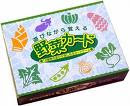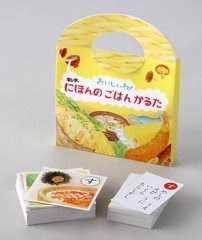[ . BACK to WORLDKIGO TOP . ]
. Mingei みんげいクッキー Folk Art Cookies .
. gangu 玩具伝説, omochcha おもちゃ toy, toys .
::::::::::::::::::::::::::::::::::::::::::::::::::::::::::::::::::::::::::::::::::::::::::::::::::::
Folk Toys (kyoodo gangu) and Food


Some
folk toys (kyoodo gangu 郷土玩具)
are depicted with food items.
Many are made of clay (tsuchi ningyoo 土人形), or straw.
some are clay bells.
mingeihin 民芸品 folk craft
minzokugaku 民俗学 anthropology, ethnology
Here I will collect them as I find them.
Daruma Doll Museum
........................................................................................................
 © PHOTO :takashi okawa. 2004
Daruma celebrating a good catch 大漁だるま
© PHOTO :takashi okawa. 2004
Daruma celebrating a good catch 大漁だるま
tairyoo Daruma, taigyo Daruma (with a big fish)
Hamamatsu Hariko Doll 浜松張り子
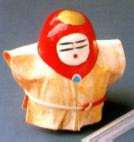 Konbu Daruma こんぶ達磨 from Himeji
Konbu Daruma こんぶ達磨 from Himeji
:::::::::::::::::::::::::::::::::::::::::::::::::::::::::::::::::::::::::::::::::::::::::::::::::::
chadoogu, mame chadoogu 豆茶道具 tea ceremony toys
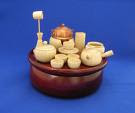 Chadoogu, mame chadoogu 豆茶道具 tea ceremony toys
Chadoogu, mame chadoogu 豆茶道具 tea ceremony toys
From Imaichi Town, 今市市 Ibaraki
They are also made in Hakone, Kanagawa and other famous woodcarving areas.
Nikko chadogu 日光茶道具 tea toys from Nikko
miniature tea-utensils
First made by the carpenters of the Nikko Toshogu shrine, in their free time.
 - source and detailed photos : tochigi-dentoukougeihin
- source and detailed photos : tochigi-dentoukougeihin
The wood mainly used is from cherry trees, Chinese quince and zelkova.
. Tochigi Folk Art - 栃木県 .
.......................................................................
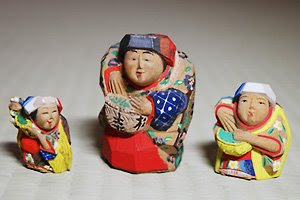 chanoki ningyoo 茶の木人形 dolls carved from the tea tree
chanoki ningyoo 茶の木人形 dolls carved from the tea tree
Uji, Kyoto
Also called
Uji Ningyoo 宇治人形, dolls from Uji
Mostly figures of women picking tea, about 5 to 10 cm high. Some are without colors.
They have been produced since the beginning of the Edo period, when
Kanamori Soowa 金森宗和 (1584-1656) Kanamori Sowa started carving a statue of the tea master Sen no Rikyu, who got his tea from Uji. Carved with one knife (ittoobori), some are almost like
netsuke.
. Kyoto Folk Art - 京都(府) .
:::::::::::::::::::::::::::::::::::::::::::::::::::::::::::::::::::::::::::::::::::::::::::::::::::
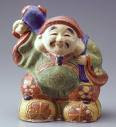 DAIKOKU 大黒天 the God of the Rice Farmers
DAIKOKU 大黒天 the God of the Rice Farmers
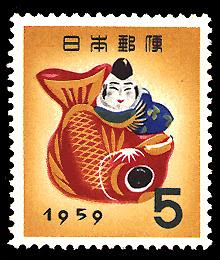 EBISU 恵比須(えびす) the God of the Fishermen
EBISU 恵比須(えびす) the God of the Fishermen
Here he is sitting on a sea bream (TAI 鯛) for additional good luck.
TAI is related to MEDETAI, an auspicious occasion.
Ebisu and Daikoku are usually pictured together.
They represent
Umi no Sachi, Yama no Sachi
the bounty of the sea and the mountains !

:::::::::::::::::::::::::::::::::::::::::::::::::::::::::::::::::::::::::::::::::::::::::::::::::::
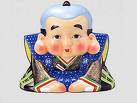 FUKUSUKE 福助
FUKUSUKE 福助
welcoming a visitor in a restaurant or shop
::::::::::::::::::::::::::::::::::::::::::::::::::::::::::::::::::::::::::::::::::::::::::::::::::::
 INARI, Fushimi Inari, 伏見稲荷 the God of Rice
INARI, Fushimi Inari, 伏見稲荷 the God of Rice
INARI and the Fox Cult
ine-uma 稲馬 horse carrying harvested rice



スゲ細工・稲馬 made from sedge
Niigata
:::::::::::::::::::::::::::::::::::::::::::::::::::::::::::::::::::::::::::::::::::::::::::::::::::::
karakuri ningyo からくり人形 mechanic dolls
Karakuri ningyō are mechanized puppets or automata from Japan from the 18th century to 19th century. The word
karakuri means a "mechanical device to tease, trick, or take a person by surprise".
© More in the WIKIPEDIA !
monkeys making soba buckwheat noodles

One is sifting flour, one is rolling the dough and one is eating the noodles. They move their arms.
From Narai Town, Nagano 奈良井
. Karakuri ningyoo からくり人形 mechanical dolls .
::::::::::::::::::::::::::::::::::::::::::::::::::::::::::::::::::::::::::::::::::::::::::::::::::::

source
http://www.asahi-net.or.jp/~SA9S-HND/agal-940-2.html
kometsuki kuruma 米つき車 wheels for pounding rice
From Aichi, Toshogu 東照宮
This is a kind of KARAKURI doll.
. Karakuri ningyoo からくり人形 mechanical dolls .
:::::::::::::::::::::::::::::::::::::::::::::::::::::::::::::::::::::::::::::::::::::::::::::::::::::
Koobe ningyoo, Kobe Ningyo 神戸人形
mechanical dolls from Kobe, Kobe Dolls

Man drinking Sake
 www.japan-toy-museum.org
www.japan-toy-museum.org
Boy cutting melon
. Kobe mechanical dolls 神戸人形 Introduction .
::::::::::::::::::::::::::::::::::::::::::::::::::::::::::::::::::::::::::::::::::::::::::::::::::::
 kijiuma, kiji-uma きじ馬 pheasant with wheels
kijiuma, kiji-uma きじ馬 pheasant with wheels
From Hitoyoshi 人吉, Kumamoto
Many craftsmen of the area made furniture. These toys were made in memory of Kyoto, since many had fled here after the Battle of Dan-no-Ura, when the Heike were defeated in 1185.
. kijiguruma きじ車 pheasant on wheels
.
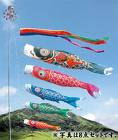 Koi nobori 鯉幟 carp streamers for Boys
Koi nobori 鯉幟 carp streamers for Boys
May 5
::::::::::::::::::::::::::::::::::::::::::::::::::::::::::::::::::::::::::::::::::::::::::::::::::::
 MANEKINEKO 招き猫
MANEKINEKO 招き猫
The beckoning cat welcoming visitors
::::::::::::::::::::::::::::::::::::::::::::::::::::::::::::::::::::::::::::::::::::::::::::::::::::
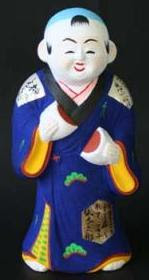 manjuu kui ningyo 饅頭食い人形 Boy Eating Manju
manjuu kui ningyo 饅頭食い人形 Boy Eating Manju
From Fushimi
Eating Manju Buns
manjuu kui ningyoo
A boy holds a bun broken in two halves, to show he loves his father and his mother equally. When asked whom he loved more, father or mother, that was his way of showing it. He broke the bun in equal halves and asked: "Which tastes better?"
Now these dolls are bought with a prayer to become pregnant and have such a clever child.

 Fushimi Clay Dolls / 伏見土人形
. Mingei Kukkii みんげいクッキー Mingei Folk Art Cookies - Manju .
Fushimi Clay Dolls / 伏見土人形
. Mingei Kukkii みんげいクッキー Mingei Folk Art Cookies - Manju .
Here are some more clay dolls with Manju buns.
http://kyoudogangu.xii.jp/mangiukui.html
 . Folk Toys from Kyoto .
. Muraoka dolls 村岡人形 - Hyogo -
. Folk Toys from Kyoto .
. Muraoka dolls 村岡人形 - Hyogo -
:::::::::::::::::::::::::::::::::::::::::::::::::::::::::::::::::::::::::::::::::::::::::::::::::::
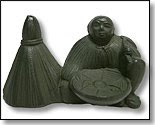 noo ningyoo 農人形 dolls of farmers
noo ningyoo 農人形 dolls of farmers
from Mito 水戸
This one is putting down his hat to collect rice grains left in the field.
Other dolls are making dried plums, fermented soy beans or ricewine.
They are made of metal.
てのひらに梅雨の重みの農人形
te no hira ni tsuyu no omomi no noo ningyoo
in my palm
the weight of farmer's dolls
wet from the rains
Kageshima Tomoko 影島智子
. Folk toys from IBARAKI / IBARAGI .
::::::::::::::::::::::::::::::::::::::::::::::::::::::::::::::::::::::::::::::::::::::::::::::::::::
sea bream (TAI 鯛) for additional good luck
TAI is related to MEDETAIめでたい, an auspicious occasion.
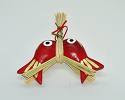
iwai tai, iwaitai 祝い鯛、祝鯛
tai sea bream for festivities
They are made from papermachee and straw and sold at the local Nishi no Miya shrine.
from Shizuoka,Yokota Town 横田町の西之宮神
.
. Hikosan no iwaidai dorei 英彦山の祝鯛土鈴
clay bell with festive sea bream .
Fukuoka
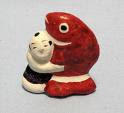 Boy with Sea Bream
Boy with Sea Bream
Fushimi Ningyoo 伏見人形 doll from Fushimi, Kyoto
also called 富山人形
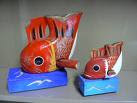 pinpin tai ピンピン鯛 sea bream "alive and kicking"
pinpin tai ピンピン鯛 sea bream "alive and kicking"
From Kusatsu, Shiga 滋賀・草津
 taiguruma 鯛車 sea bream on a float
taiguruma 鯛車 sea bream on a float
Izumo, Miyoshi and other towns
:::::::::::::::::::::::::::::::::::::::::::::::::::::::::::::::::::::::::::::::::::::::::::::::::::::
tawara ushi 俵牛 ox carrying rice barrels



There are many types in Japan. Some are clay bells. They are important auspicious items to thank for a good harvest.
::::::::::::::::::::::::::::::::::::::::::::::::::::::::::::::::::::::::::::::::::::::::::::::::::::
warazaiku 藁細工 things made from straw



During the winter months, many things were made from rice straw. Mostly necessities like sandals, raincoats and hats, but also some toys and auspicious decorations with rice barrels.
*****************************
Worldwide use
*****************************
Things found on the way
A lullaby
Nenneko, nenneko nenneko ya!
Kono ko nashite naku-yara?
O-chichi ga taranuka? — o-mama ga taranuka?
Ima ni ototsan no ōtoto no o-kaeri ni
Ame ya, o-kashi ya, hii-hii ya,
Gara-gara, nagureba fuito tatsu
Oki-agari koboshi! — 起き上がり小法師
Neneko, neneko, nenneko ya!
 Okiagari koboshi Rolly-Polly Dolls
Sleep, sleep, sleep, little one!
Okiagari koboshi Rolly-Polly Dolls
Sleep, sleep, sleep, little one!
Why does my baby continue to cry?
Is the honorable milk not enough?
is the honorable rice not enough?
Presently when father returns from the Lord's palace,
Sweets will be given to you, and also cake,
and all you want !
And a rattle as well, and a rolly-polly doll
That will stand up immediately
after being thrown down.
Sleep, sleep, sleep, little one!
:::::::::::::::::::::::::::::::::::::::::::::::::::::::::::::::::::::::::::::::::::::::::::::::::::::
External Links
with many photos
郷土玩具展示室
http://homepage3.nifty.com/indymuseum/page130.html
Japan Toy Museum 日本玩具博物館
English Homepage
http://www.japan-toy-museum.org/english/eindex.htm
omocha おもちゃ Cooking Toys
:::::::::::::::::::::::::::::::::::::::::::::::::::::::::::::::::::::::::::::::::::::::::::::::::::
Japanese cooking toys おもちゃ
There has been a boom in cooking toys in Japan. Those toys are so attractive that even adults buy them for themselves. Some of popular cooking toys are Takara Tommy's
taiyaki (traditional Japanese fish-shaped cake) makers and
soft caramel candy makers, Sega Toy's
ice cream makers, and Bandai's
norimaki (sushi rolls) makers. Using cute cooking toys, both kids and adults can have fun at home.
source : Shizuko's Japan Travel Blog . gojapan.about
International Tokyo Toy Show 2009 .
*****************************
HAIKU and SENRYU
丑三のわら人形が笑ふ夜
ushimitsu no wara ningyoo ga warau yoru
after midnight
the straw doll laughs-
what a night
or more literal
the night when
the straw doll laughs
after midnight
anonymous senryu
 藁人形 wara ningyo,
藁人形 wara ningyo,
a doll used for making a wish to kill or harm a person. At midnight, a nail is hit through the heart of the doll to fix it to a tree in a shrine.
ushi mitsu, the old double-hour of the ox beginning at one o'clock.
mitsu signifies the third part of this time slot. A time when the spirits of the dead and the gods are alive too.
"a time when the trees and plants are asleep"
草木も眠る丑三つ時
:::::::::::::::::::::::::::::::::::::::::::::::::::::::::::::::::::::::::::::::::::::::::::::::::::::
Kobayashi Issa 小林一茶

source
http://380334.com/SHOP/0200.html
Kobayashi Issa (June 15, 1763 - January 5, 1828)
*****************************
Related words
Daruma Doll Museum
Tairyoobata (tairyobata) 大漁旗 Ships Flags ...
and Big Fish Catch, Tairyoo 大漁 Daruma Doll
*****
WASHOKU : General Information
*****
. Regional Folk Toys from Japan .
:::::::::::::::::::::::::::::::::::::::::::::::::::::::::::::::::::::::::::::::::::::::::::::::::::::::::::::::::::::::::::
. hassaku dango no uma 朔だんご馬/ 八朔団子馬 horse offerings for Hassaku .
Sanuki, Kagawa
玩具菓子 - 郷土玩具と菓子、または遊び菓子 - tba
縁起菓子筑後吉井の七夕麦菓子
甘木のばたばた豆太鼓煎餅
天神堂あそび
縁起菓子砂糖人形の土型
言葉入りキャラメル「カランバ」
製菓用?陶器人形
芦屋かるたと八朔の「だごびーな」
おけそくとキリサゲ
クリスマス・クラッカーと「豆の王」
うんちをするおじさん
唐子落雁
飴細工で復活祭のうさぎ
縁起菓子お菓子でできた天神さま
金花糖のこけし
神農さんの豆神虎
笹野一刀彫「古代ぽっぽ」
ペルーの生誕人形「ナシミエント」
中国の竈の神様の紙衣
京都三宅八幡の土の鳩と餅の鳩
川崎巨泉の玩具絵のなかの「ちんころ」
吉備津神社の「こまいぬ」
縁起菓子天神さんと線香花火
縁起菓子宮島の「たのもさん」
縁起菓子痴娯の家の「犬っこ」
ふの字尽しの菓子型
縁起菓子金沢の福徳
縁起菓子会津の小法師
あてもの菓子 . 弘前の生大王
赤坂土人形
- source : m-mizoguti.com -
:::::::::::::::::::::::::::::::::::::::::::::::::::::::::::::::::::::::::::::::::::::::::::::::::::::::::::::::::::::::::::
. gangu 玩具伝説, omochcha おもちゃ toy, toys .
Spielzeug und Legenden
. Mingei みんげいクッキー Folk Art Cookies .
[ . BACK to DARUMA MUSEUM TOP . ]
[ . BACK to WORLDKIGO . TOP . ]
:::::::::::::::::::::::::::::::::::::::::::::::::::::::::::::::::::::::::::::::::::::::::::::::::::::::::::::::::::::::::::










